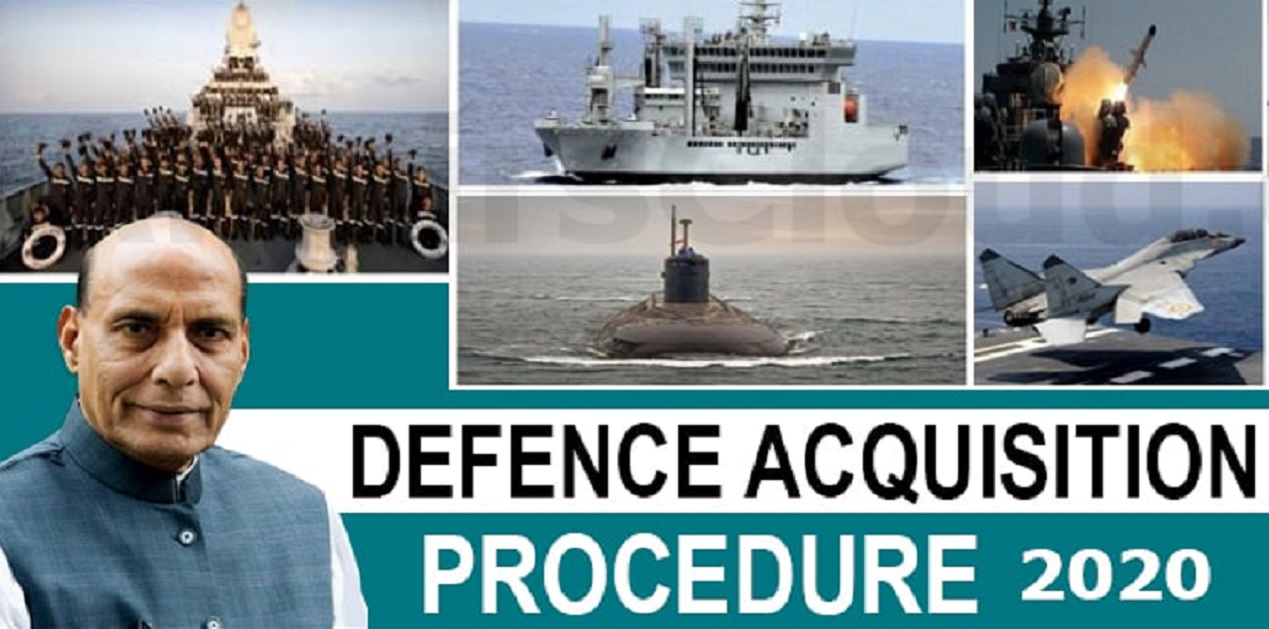The Defence Acquisition Procedure 2020 (DAP2020) [1] aims at optimal utilisation of the allocated budget for timely acquisition of military equipment, systems and platforms meeting the desired parameters of performance, capabilities and quality standards. It also pledges steadfast pursuit of self-reliance in defence production, while simultaneously maintaining the highest degree of probity, public accountability, transparency, fair competition, and level-playing field for the private and public sector industries.[2]
Starting from 2022, all versions of the Defence Procurement Procedure which preceded DAP2020 also had similar aims and made similar pledges. Meanwhile, the Ministry of Defence (MoD) has also taken several policy initiatives and made procedural changes to achieve the stated objective. Nevertheless, defence acquisitions continue to face many challenges.
In the absence of an empirical study, it is not possible to conclusively identify those challenges but, based on experience, one can theorise that there are at least five intertwined challenges which potentially bedevil capital acquisition programmes to varying degrees.
Amorphous Security Policy Framework for Military Capability Development
Most analysts argue that it is not possible to plan capability development properly in the absence of a National Security Strategy which is a prerequisite for laying down the Defence Planning Guidelines, Capability Development Strategy, and other policy directives, although their absence has never come in the way of the armed forces drawing up acquisition plans based on Raksha Mantri’s Operational Directives, or RM’s Op Directives.
Being classified, not much is known about these directives, the acquisition plans based on them, or the results achieved at the end of each planning period. But it is widely acknowledged that India is lagging in modernisation of the armed forces, though it is debateable whether this is because of a guiding policy framework. Some other factors contribute to this enduring problem, as discussed below.
Defence Planning
At least in theory, all acquisition proposals for capability development emerge from the three-tiered planning process. The 10-year long-term Integrated Capability Development Plan comprises two five-year Defence Capital Acquisition Plans. The latter are broken down into two-year roll-on Annual Acquisition Plans which then form the basis of each acquisition proposal initiated by the armed forces.[3]
This planning process is fundamentally flawed for three-though not the only- reasons. One, the defence plans are not all-inclusive in that these are only focussed on the armed forces. These plans do not cover other important MoD constituents like the Research and Development Organization, Indian Coast Guard, and Border Roads Organisation.
Two, there is no overarching 24x7 professional organisation for comprehensive and all-inclusive defence planning. Several agencies such as the Defence Planning Committee set up in 2018 under the chairmanship of the National Security Advisor, Services Headquarters, Headquarters Integrated Defence Staff, and various MoD departments, play amorphous -and potentially conflicting- roles in formulation of the plans.
Three, financial viability is not kept in view while formulating the plans, such as they are. Areas like defence pensions which account for a significant proportion of the defence budget are not factored in. This unrealism is best illustrated by the plan presented at the Unified Commanders’ Conference in July 2017 which envisaged an outlay of Rs 26.84 crore ‘over the next five years to ensure requisite military modernisation and maintenance to take on the collusive threat from Pakistan and China as well as to safeguard India’s expanding geostrategic interests’[4].
To put it in perspective, it would have necessitated at least doubling of the armed forces’ budget, excluding the money required for other defence organisations and pensions -a near impossibility by any stretch of imagination. It is difficult to visualise what purpose is served by financially unviable planning. If anything, it can only disrupt the capability development and acquisition plans on account of paucity of funds.
Absence of a Bespoke Defence Capability Acquisition Organisation (DCAO)
A loosely structured organisation, mainly comprising the Defence Acquisition Council, Defence Procurement Board, Services Procurement Board (which replaced the two categorisation committees in 2020), and Capital Acquisition Wing, was created in 2001 to handle capital procurements. All of them have vertical and lateral linkages with the Departments of Defence, Defence Production, Research and Development, and Military Affairs, apart from the Finance Division, Coast Guard, Services Headquarters, and Headquarters Integrated Staff.
With the administrative and financial powers relating to various procurement-related functions being exercised by at least half a dozen authorities in the Services Headquarters and the MoD, with different lines of command of control, this structure is not conducive to cohesive and expeditious decision making.
Recognising this problem, the MoD had set up a committee to examine the feasibility of replicating successful models like the US government’s Defence Advanced Research Projects Agency (DARPA) and the French Direction Générale de l'armement (DGA), which is responsible for technology development and purchase of weapon systems for the French military, as well as programme management.[5]
In 2017, the committee recommended creation of a compact and autonomous Defence Acquisition Organisation for handling the entire gamut of activities from the time the operational requirements were identified by the armed forces till the induction and sustenance of the equipment, platforms, and weapon systems.[6]
In keeping with the best global practices, this organisation, run by professionals not constrained by the central staffing norms, was designed to integrate procurement with research and development and ensure continuity in the interface with all stakeholders including the Indian and foreign defence industry. Inexplicably, nothing came out of the committee’s recommendations, upending the MoD’s initiative.
Procedural complexities
Despite at least eight iterations since 2002, the procurement procedures continue to be seen by the principal players as cumbersome. Within less than a year of promulgation of the DAP2020, General MM Naravane, then Chief of Army Staff, roundly criticised the procedural complexities, calling for a‘revolution in bureaucratic affairs’ to address the problem of tardy decision making which, in turn, is related to the procedural complexities. [7]
Theprocedural complexities are on account of the multi-stage acquisition cycle, processes linked with each stage in the cycle being inadequately defined, formulation of unrealistic Services Qualitative Requirements (SQRs), lack of expertise in areas like costing and commercial negotiations, textual ambiguities in the procurement manuals, excessive controls by the MoD, weak contract management, and lack of transparency in decision making. No wonder then that many acquisition programmes run into some difficulty before or after the contract is awarded.
Budgetary constraints
Last, but not the least, the perennial shortage of funds foracquisition and sustenance of equipment has been a big challenge. The gap between the requirement projected by the armed forces and the budgetary allocation increased from Rs 23,014 crore in 2010-11 to Rs 1,01,678 crore in 2022-23, of which Rs 37,438 crore is under the capital segment of the defence budget which caters for acquisition of the new equipment and upgradation of the existing inventory.[8]
In its 2020 report, the Fifteenth Finance Commission recommended setting up of a non-lapsable Defence Modernisation Fund with a corpus of Rs 1,38,354 crore (excluding Rs 50,000 crore meant for the internal security organisations). With this limited corpus, the yet-to-be established Modernisation Fund cannot meet the expected shortfall of Rs 4,59,979 core for revenue expenditure and Rs 5,27,491 crore for capital expenditure between 2023-24 and 2025-26.[9]
While other challenges can be managed, the problem of inadequate financial resources cannot be easily addressed any time soon. The only pragmatic solution seems to be to formulate financially viable defence plans. It may sound difficult, if not impossible, but then making financially unviable plans too does not serve any purpose.
Endnotes :
[1]Available at https://www.mod.gov.in/dod/sites/default/files/DAP202013Apr22.pdf
[2] Ibid., Chapter 1: Acquisition Categories, Acquisition Planning and Indigenous Content, para 1.
[3]Ibid., Chapter 1: Acquisition Categories, Acquisition Planning and Indigenous Content, Paras 24-28
[4]Rajat Pandit, ‘Forces seek Rs 27 lakh crore over next 5 years for defence projects’, The Times of
India, July 16, 2017, accessible at https://timesofindia.indiatimes.com/india/forces-seek-rs-27-lakh-crore-over-next-5-years-for-defence-projects/articleshow/59613786.cms
[5]Manu Pabby, ‘MoD panel for autonomous weapons acquisition body in charge of policy, acquisition and exports’, The Economic Times, July 14, 2018, accessible at https://economictimes.indiatimes.com/news/defence/mod-panel-for-autonomous-weapons-acquisition-body-in-charge-of-policy-acquisition-and-exports/articleshow/58796326.cms?from=mdr
[6]Manu Pabby, ‘MoD panel for autonomous weapons acquisition body in charge of policy, acquisition, and exports’, the Economic Times, May 23, 2017 (updated July 14, 2018), accessible at https://economictimes.indiatimes.com/news/defence/mod-panel-for-autonomous-weapons-acquisition-body-in-charge-of-policy-acquisition-and-exports/articleshow/58796326.cms?from=mdr
[7] Amit Cowshish, ‘Outrage cannot improve defence acquisition procedures’, The Financial Express, August 11, 2021, accessible at https://www.financialexpress.com/defence/outrage-cannot-improve-defence-acquisition-procedures/2308494/
[8]The figures relating to shortage of funds have been worked out based on the information available in the reports of the Standing Committee on Defence for the relevant years.
[9]Figures based on Table 11.5 at p/340 in the report of the Fifteenth Finance Commission, accessible at https://fincomindia.nic.in/ShowContentOne.aspx?id=9&Section=1
(The paper is the author’s individual scholastic articulation. The author certifies that the article/paper is original in content, unpublished and it has not been submitted for publication/web upload elsewhere, and that the facts and figures quoted are duly referenced, as needed, and are believed to be correct). (The paper does not necessarily represent the organisational stance... More >>
Image Source: https://affairscloud.com/assets/uploads/2020/10/Defence-Acquisition-Procedure-2020.jpg











Post new comment